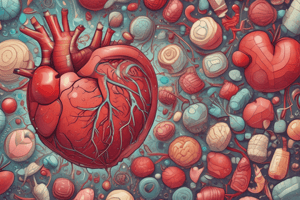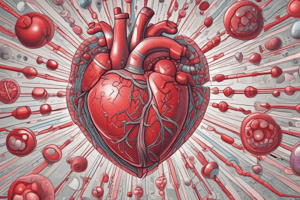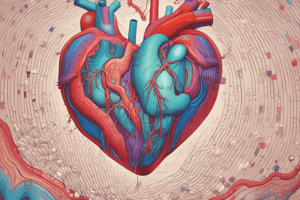Podcast
Questions and Answers
What mechanism does warfarin use to exert its anticoagulant effect?
What mechanism does warfarin use to exert its anticoagulant effect?
- Direct activation of thrombin
- Binding to antithrombin III
- Inhibition of vitamin K epoxide reductase (VKOR1) (correct)
- Inhibition of factor 10 alone
Which of the following agents is used as a reversal agent for heparin?
Which of the following agents is used as a reversal agent for heparin?
- Idarucizumab
- Aspirin
- Andexanet alfa
- Protamine sulfate (correct)
What is the primary action of enoxaparin?
What is the primary action of enoxaparin?
- Binding to vitamin K
- Inactivation of factor 10 (correct)
- Directly inhibiting thrombin
- Inhibition of factor 2
Which anticoagulant can cause skin necrosis?
Which anticoagulant can cause skin necrosis?
Which of the following statements about rivaroxaban is incorrect?
Which of the following statements about rivaroxaban is incorrect?
What is the primary role of cilostazol?
What is the primary role of cilostazol?
What distinguishes dabigatran from other anticoagulants?
What distinguishes dabigatran from other anticoagulants?
Which antiplatelet drug irreversibly binds to the P2Y12 ADP receptor?
Which antiplatelet drug irreversibly binds to the P2Y12 ADP receptor?
What is the primary adverse effect associated with thrombolytics like alteplase?
What is the primary adverse effect associated with thrombolytics like alteplase?
What is the main action of statins?
What is the main action of statins?
Which of the following uses increase LDL clearance primarily via the LDL receptor?
Which of the following uses increase LDL clearance primarily via the LDL receptor?
What is the primary effect of niacin in lipid management?
What is the primary effect of niacin in lipid management?
Which combination of medications is indicated for elevated triglycerides?
Which combination of medications is indicated for elevated triglycerides?
Which class of drugs primarily prevents the conversion of angiotensinogen to angiotensin I?
Which class of drugs primarily prevents the conversion of angiotensinogen to angiotensin I?
Which beta-blocker is non-selective and affects both beta1 and beta2 receptors?
Which beta-blocker is non-selective and affects both beta1 and beta2 receptors?
Which class of medications is most effective for lowering serum triglycerides and increasing HDL levels?
Which class of medications is most effective for lowering serum triglycerides and increasing HDL levels?
What adverse effect is commonly associated with ACE inhibitors?
What adverse effect is commonly associated with ACE inhibitors?
Which medication is a selective blocker of beta1 receptors and often prescribed for hypertension?
Which medication is a selective blocker of beta1 receptors and often prescribed for hypertension?
What mechanism do bile acid sequestrants primarily use to lower LDL cholesterol?
What mechanism do bile acid sequestrants primarily use to lower LDL cholesterol?
Which drug class decreases blood pressure by limiting intracellular calcium levels?
Which drug class decreases blood pressure by limiting intracellular calcium levels?
Flashcards
Statin Pharmacokinetics
Statin Pharmacokinetics
Statins' absorption after oral intake varies.
Statin Cholesterol Reduction
Statin Cholesterol Reduction
Statins lower LDL by reducing liver's VLDL production and increasing LDL receptor clearance.
Niacin's Effect on Lipids
Niacin's Effect on Lipids
Niacin reduces VLDL and LDL, and significantly raises HDL by inhibiting fat release.
Bile Acid Sequestrants
Bile Acid Sequestrants
Signup and view all the flashcards
Ezetimibe's Action
Ezetimibe's Action
Signup and view all the flashcards
Statins and Resins Combination
Statins and Resins Combination
Signup and view all the flashcards
Diuretics' Blood Pressure Effect
Diuretics' Blood Pressure Effect
Signup and view all the flashcards
Beta-Blockers' Mechanism
Beta-Blockers' Mechanism
Signup and view all the flashcards
ACE Inhibitors' Action
ACE Inhibitors' Action
Signup and view all the flashcards
Calcium Channel Blockers' Function
Calcium Channel Blockers' Function
Signup and view all the flashcards
Warfarin's Mechanism
Warfarin's Mechanism
Signup and view all the flashcards
Heparin's Action
Heparin's Action
Signup and view all the flashcards
Enoxaparin's Function
Enoxaparin's Function
Signup and view all the flashcards
Protamine Sulfate's Role
Protamine Sulfate's Role
Signup and view all the flashcards
Fonaparinux's Action
Fonaparinux's Action
Signup and view all the flashcards
Direct Factor Xa Inhibitors
Direct Factor Xa Inhibitors
Signup and view all the flashcards
Aspirin's Mechanism
Aspirin's Mechanism
Signup and view all the flashcards
Clopidogrel's Action
Clopidogrel's Action
Signup and view all the flashcards
Alteplase Function
Alteplase Function
Signup and view all the flashcards
Statins' Action
Statins' Action
Signup and view all the flashcards
Study Notes
Warfarin
- Vitamin K antagonist
- Inhibits factors 2, 7, 9, and 10
- Inhibits VKOR1
- Reduces clotting factors due to lack of gamma-carboxylglutamyl side chains
- Used for prosthetic heart valves
- Requires bridging drugs (heparin or enoxaparin) initially due to hypercoagulability
- Reversal: Vitamin K + 4F-PCC or FFP (non-life threatening)
- Contraindicated in pregnancy
- INR target range 2-3
- Oral administration
Heparin
- Highly acidic
- Binds to antithrombin III via pentasaccharide complex
- Inactivates factors 2 and 10
- Subcutaneous or IV administration (prophylaxis)
- Adverse effects: bleeding, Heparin-induced thrombocytopenia (HIT)
Enoxaparin
- Low-molecular-weight heparin (LMWH)
- Binds to antithrombin III via pentasaccharide complex
- Inactivates factor 10
- Subcutaneous injections
- Adverse effects: bleeding, HIT (greater risk than heparin)
- Protamine sulfate is used for reversal (partially effective for enoxaparin)
Fondaparinux
- Pentasaccharide
- Inhibits factor 10 via antithrombin III
- Injectable
- Contraindicated in renal disease
- No reversal agent
Rivaroxaban and Apixaban
- Direct factor 10 inhibitors
- Oral tablets
- Contraindicated in renal disease
- Reversal agents exist (andexant alfa for rivaroxaban)
Dabigatran
- Direct thrombin inhibitor
- Oral prodrug
- Contraindicated in renal disease
- Reversal agent (idarucizumab)
Other Drugs
- Bivalirudin and argatroban: direct thrombin inhibitors
- Alteplase: thrombolytic (for acute ischemic stroke)
- Aspirin: COX inhibitor (acetylation of a serine residue on COX, reduces TxA2, GI bleeding and ulcer risk)
- Clopidogrel andticagrelor: P2Y12 ADP receptor inhibitors
- Abciximab and eptifibatide: GPIIb/IIIa inhibitors
- Cilostazol: PDE3 inhibitor (inhibition of PDE3 resulting in decreased catabolism of cAMP)
- Statins: HMG-CoA reductase inhibitors
Cholesterol-Lowering Drugs
- Competitive inhibitors (inhibiting de novo synthesis, deplete intracellular supply of cholesterol, plaque stabilization, improvement of coronary endothelial function)
- Statins: reduce LDL cholesterol principally by increasing LDL clearance via the LDL receptor
- Nicotinic acid (niacin): strongly inhibits lipolysis, reduce VLDL and LDL, increase HDL
- Fibric acid derivatives (fibrates): increase HDL levels, reduce triglycerides
- Bile acid sequestrants: bind bile acids and bile salts in the small intestine, increase LDL receptors
- Ezetimibe: selectively inhibits cholesterol absorption in the small intestine
Other Information
- Adverse effects are mentioned for many of the drugs, including bleeding and other complications.
- Contraindications are discussed for certain conditions (e.g., renal disease)
- Reversal agents/alternatives are mentioned where applicable.
Studying That Suits You
Use AI to generate personalized quizzes and flashcards to suit your learning preferences.
Related Documents
Description
Test your knowledge on anticoagulants including Warfarin, Heparin, and Enoxaparin. This quiz covers their mechanisms, uses, contraindications, and reversal strategies. Perfect for students in pharmacology or medicine.




